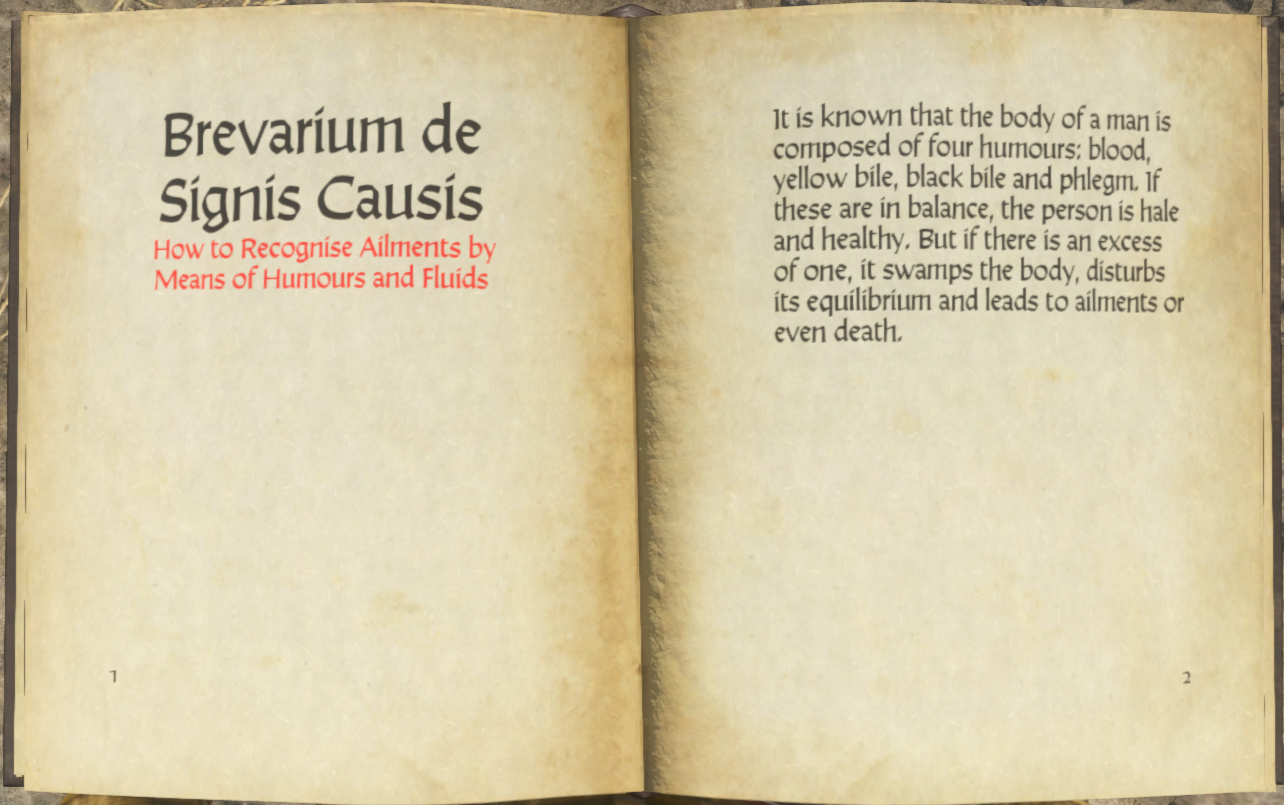Breviarium
The Breviarum de Signis Causis, often called simply the Breviarium, is a quest document in Kingdom Come: Deliverance, by Johann of Saint Paul.
Although originally written in Latin, the Librarian of the Sasau Monastery has translated it into the common tongue, and Brother Nicodemus keeps a copy on display in his herbarium in the Sasau Infirmary. Henry will need to read it in Pestilence in order to find the cure for Merhojed.
Description
The Breviarium de Signis, Causis et Curis Morborum is a 13th century book on symptoms and ailments written by Johannes de Sancto Paulo.
Text
Brevarium de Signis Causis
How to Recognise Ailments by Means of Humours and Fluids
It is known that the body of a man is composed of four humours: blood, yellow bile, black bile and phlegm. If these are in balance, the person is hale and healthy. But if there is an excess of one, it swamps the body, disturbs its equilibrium and leads to ailments or even death.
... The excess of mucous may also lead to diphtheria, for example. The body endeavours to get rid of it by coughing, sometimes spasmodically. It leaves sores in the throat and mouth that trouble the sick and complicate the intake of fluids. The whole agony is further exacerbated by fever, often accompanied by malaise. After a few days, a rash or spots appear. People often become infected by association with a sufferer, but not everyone so succumbs to the infection. Diptheria does not infect animals, nor do the suffer from it.
Plague, caused by black bile fluctuations, often exhibits many signs. These include fever accompanied by malaise, often alternated with a spastic cough, perhaps even diarrhoea, when the body endeavours to rid itself of excess black bile, and great thirst. After a few days, sores erupt on the body, on the neck under the jaw, in the armpits and groin. Later black spots are seen on the fingers, nose, mouth, and other protrusions of the human body where accumulated gall settles. It spreads among people, but some people are not afflicted. Small animals do not suffer from the plague, but bigger ones may be infected.
A profusion of yellow bile can lead to dysentery, which is manifested by various signs, primarily by violent diarrhoea. Vomiting is present only rarely. The sick also suffer from terrible thirst, abdominal cramps and fever. It is transmitted from person to person, but animals do not suffer from it.
But there are also other ways in which the inner humours are disturbed and the blood weakened. One such is by poisoning, which is manifested by fever and delirium, stomach ache bringing convulsions, diarrhoea and great thirst. If a person is poisoned by gas, for example in mines, near swamps or similar places, there often appears on him a rash around the nose and mouth. However, this rash does not occur if the poison is ingested through food consumed. Poisoning is not transmitted between humans or animals, but if they all drink, for example, from the same source of water, then people are inflicted as well as animals, the latter often sooner.
An interesting case of imbalance of internal fluids is the Saint Vitus dance, which is manifested by the inflicted dancing wildly, contorting and twisting; they may also sing, scream or lament. They move as if in a trance and wander deliriously. They may dance for days, weeks or even months, generally until they become exhausted or die. Some may strip off their clothes and devote themselves to sins of the flesh. In one case, dancers were helped by falling from a bridge into the river below; those who did not drown or die from the fall came to themselves and ceased to dance. It has been reported that this dance plague is highly contagious, although it only affects humans and not animals. St. Vitus dancers who tried to draw animals into their capers ended up kicked and bitten.

